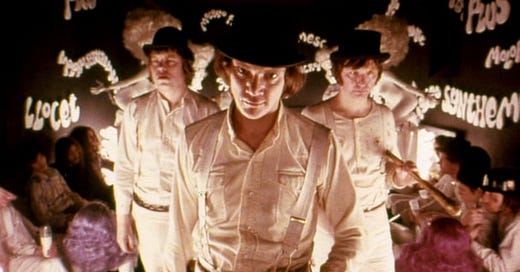As readers will know by now, I did not enjoy re-reading A Clockwork Orange, a novel I thought was edgy and exciting when I was much younger but found tedious and exhausting now that I’m older and less concerned about edginess.
Mostly it was the Nadsat slang—the endless barrage of chepooka—that wore me down. The fact that Burgess’s protagonist, Alex, is such a rotten bastard didn’t help. And I found the final chapter, originally excluded from the publication of the American novel and also missing from the film, to be a bit of a cop out. Burgess claimed it helps illustrate his point, that people must be able to choose between good and evil to be truly human, and that even wicked folk like Alex have the capacity to change of their own free will. But the change in question felt abrupt to me and unearned.
Ending with Alex in the hospital, imagining more ultra-violence to come and saying “I was cured alright” is simply a better ending.
The movie fixes most of the novel’s problems. The Nadsat is more bearable when spoken rather than read. There’s less of it. Alex is still presented as being very young, but he’s played by a grown man and it feels less jarring. The novel’s three-way is a rape with two very young girls. The movie’s is just a threesome, in fast-forward, with two young women.
Alex is still loathsome and vile in the movie but it’s less of a slog all around. It’s not that the book’s pacing is terrible. It’s just a chore to read, whereas the movie is stylish and even a little sexy, however troubling it may be. Kubrick paints a bleak, bizarro dystopian society that oozes late 60s’ early 70s’ chic. It’s futuristic around the edges. The attention to detail means every frame is something to pour over. The tables in the Korova Milk Bar, the graffiti in the apartment building where Alex lives with his parents, the costumes of Alex and his droogs. When they first encounter another group of malchicks, this other group is tearing off some poor devotchka’s clothes on an old, abandoned stage.
The addition of the song Singin’ In The Rain is another brilliant little twist that makes Alex’s captivity and attempted suicide a much more clever and effective scene in the film than in the novel.
Perhaps on some levels this was a story better suited to cinema than prose. Alex’s obsession with Beethoven works better when we can actually hear the music. When he’s going through his brainwashing sessions, the visuals are so jarring. Same with Alex’s assault on the writer and his wife, cutting away her clothing while belting out “I’m singing in the rain!” as Dim laughs and sputters in the background; or Alex’s final botched robbery, as he dances around with the giant penis statue. The decadence and clownery of it all is more striking on a screen. The droogs in their masks codpieces, the thrummingly ominous synth score, the lecherous old parole officer, Mister Deltoid.
Add to this Malcolm McDowell and his absolutely riveting performance. The casting of the film’s main character could not have been better. McDowell is pitch perfect—if a little old to be believable as a teenaged hooligan.
Ultimately, this is one of those rare adaptations that outshines the original work in almost every way. Burgess is a terrific writer, but A Clockwork Orange is just not an enjoyable novel. Stanley Kubrick’s film, while certainly disturbing and hard to watch at times, distills the story down to its essentials while enriching it with style and sound and visual flourishes you simply don’t get while reading the book.
What did you think? Did you prefer one over the other? Let me know and thanks for bearing with me on this first book club. It was a slog for me and I hope the next one is more fun for everyone. Speaking of the next one, I’ll be posting that shortly. Of course, I’m traveling at the moment so I’m not sure we’ll kick that off until next week. Stay tuned…




